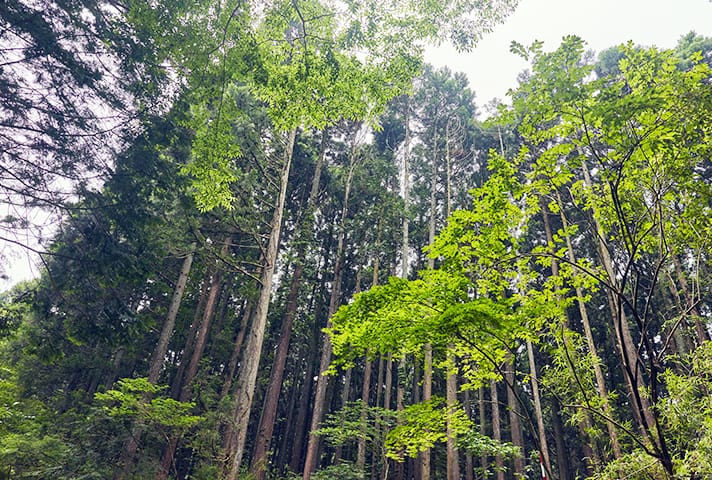Reforestation and Marine Environmental Preservation
In June 2023, a dignified ceremony was held in a forest in Gotemba, Shizuoka Prefecture. Intended to appease the tree spirits that inhabit the forest, the ceremony included felling, sawing, and axing ceremonies, as NYK launched its Yu no Mori reforestation project in the presence of many of those involved.
In this long-term project, Group employees will work together with the local community to create a forest with a wide variety of vegetation by regenerating a man-made forest of mainly cedar, Japanese cypress, and other coniferous trees.
The “yu” in Yu no Mori has a three fold reference: the “yu” in Nippon Yusen, the “yu” reading of the kanji for friend, and “you” in English. The name “Yu no Mori” expresses the hope that Group employees will develop a sense of ownership with respect to environmental preservation and use this opportunity to advance activities in partnership with various stakeholders.
What is the significance of NYK’s reforestation efforts? Hiroshi Maniwa, the manager of the reforestation project, explains,
“We began by considering how NYK could give back to the oceans because its businesses have always been reliant on them.”
The project traces its roots to former NYK president Hitoshi Nagasawa. He realized that although the Company was involved in many ocean-related social contribution activities, it conducted few such activities on land. Maniwa outlines the thinking that led to the project.
“Oceans are cleaned by rivers. Rivers are cleaned by mountains. Therefore, we concluded that we should improve upstream areas through reforestation.”
Reforestation strengthens watershed protection functions, thereby helping preserve the marine environment.
Another goal of the project is to raise NYK Group employees’ awareness of environmental and social issues and foster a sense of solidarity among employees as forest development volunteers.
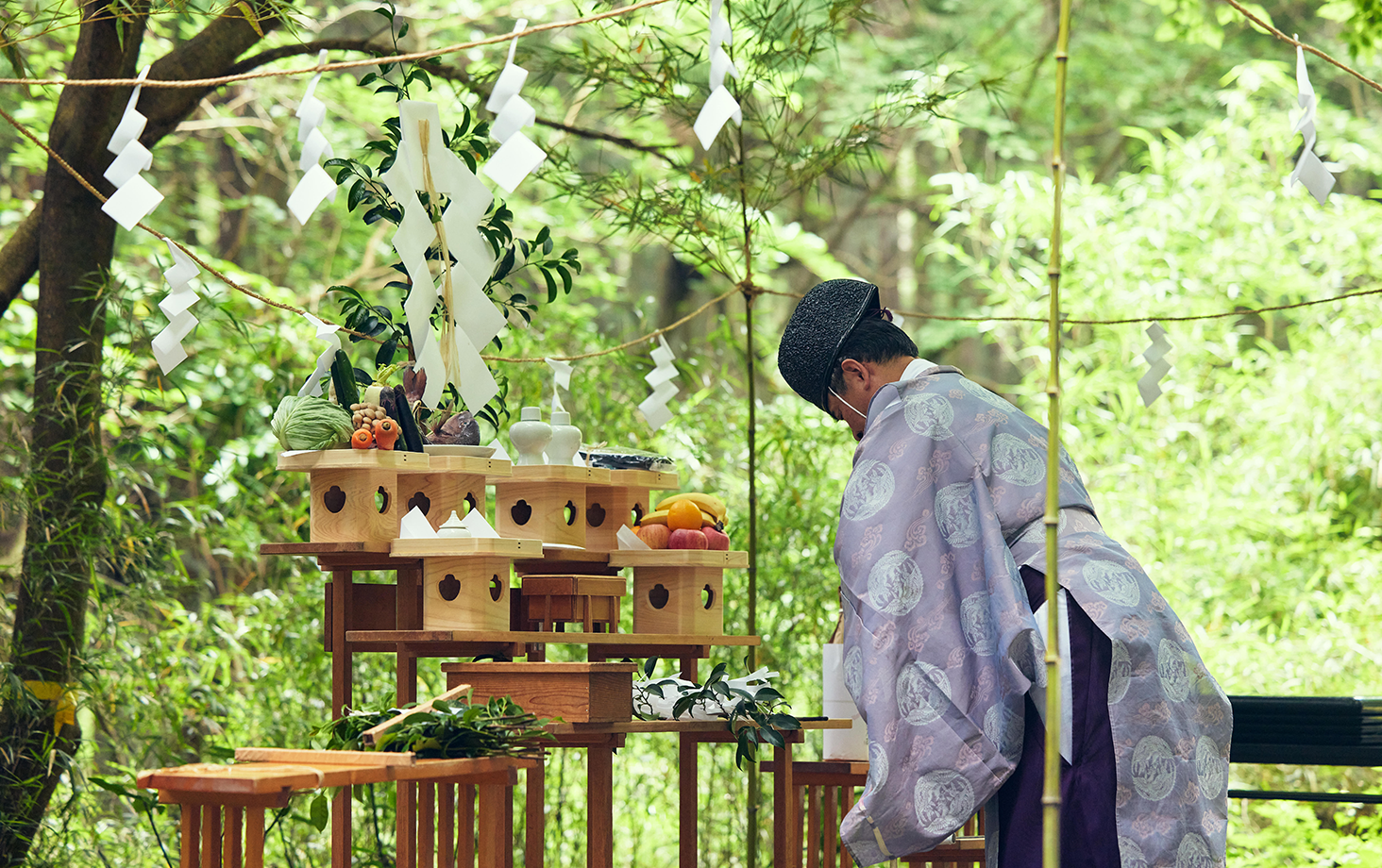
Origins of the Yu no Mori Project
The project manager, Maniwa, joined NYK in 1985. His partner in the project is Satoshi Okita, who joined Yusen Air & Sea Service Co., Ltd. (now Yusen Logistics Co., Ltd.) in the same year. The two, both of whom spent their entire working careers at the NYK Group, teamed up following retirement.
In the 2021 New Year period, Maniwa received a phone call from Nagasawa, NYK’s president at the time. He asked if Maniwa could help with forest development. The sudden request surprised him. However, he happened to have recently taken up survival camping as a hobby and had an interest in forests. After considering the request for a few days, he told Nagasawa that he would gladly take on the task. The project was later approved as an NYK Group Sustainability Initiative*1 through an internal process. Maniwa then became a member of the ESG Management Group’s Sustainability Initiative Team, the department in charge of the project.
Around the same time, Okita retired from Yusen Logistics. He had already been reemployed, but after watching Maniwa persevere alone, Okita offered to participate in the project, joining in 2022.
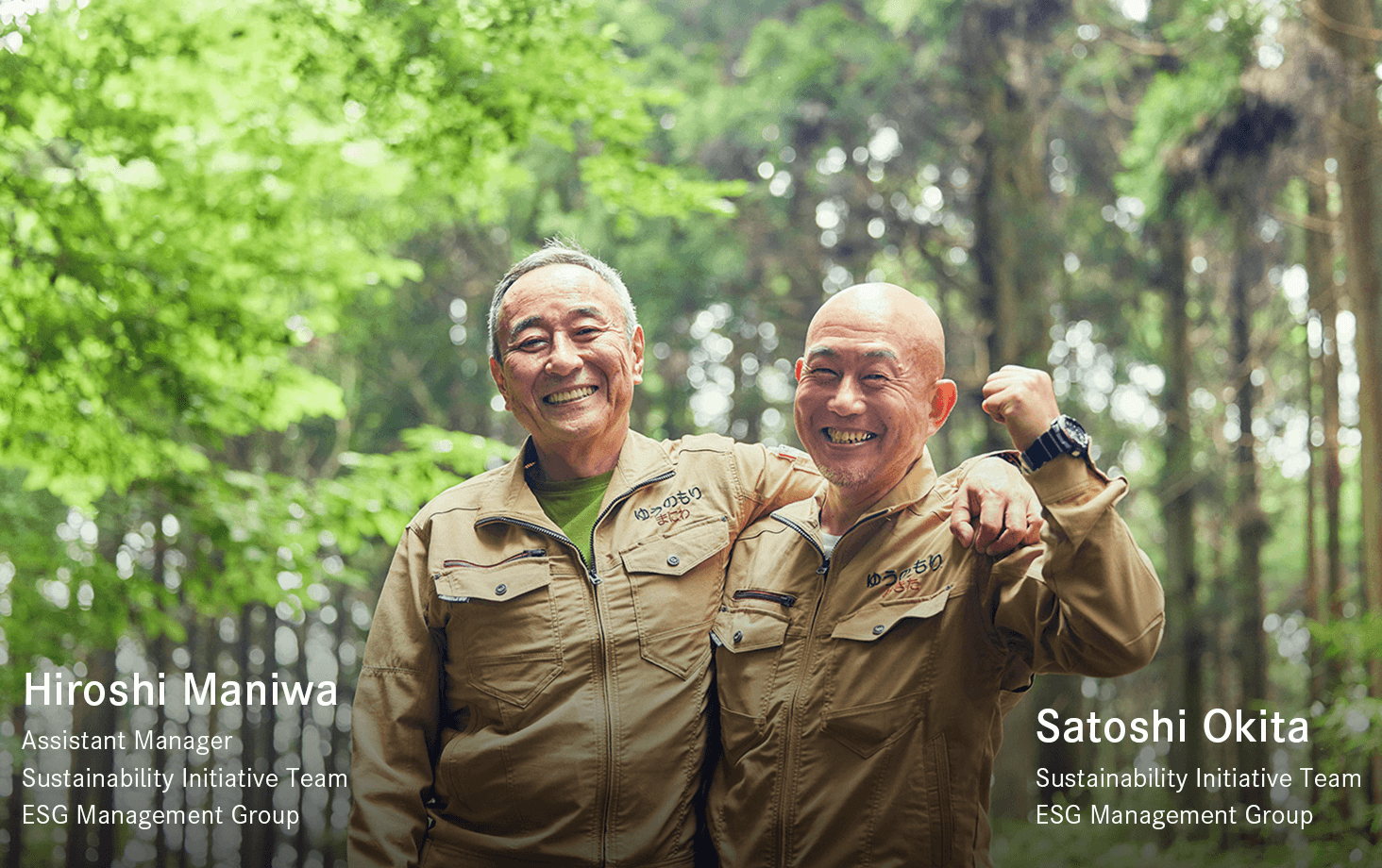
Although Maniwa now strongly advocates measures to address Japan’s forest issues, he initially did not know much about forestry and wondered how to learn more. He was uncertain about how to proceed because no one in the Company was familiar with forestry. In the end, his son advised him to acquire a qualification as a forest instructor. Maniwa then set himself the goal of acquiring this qualification because it encompassed a well-balanced mix of subjects, including forests, forestry, forest-based outdoor activities, safety, and education.
“I have been studying since I learned about the qualification, but it is tough. I want to do my best to obtain this qualification.”
Also, preparations for the Yu no Mori project have involved working with forestry consultants and other experts, enabling Maniwa to gain a variety of practical knowledge in the field.
The preparations were not always straightforward. One challenge was applying for a permit. The application procedures for the project were very different from those required in the international maritime shipping industry, where he had previously worked.
The application process for a permit took a long time and included research on related laws and regulations, negotiations with relevant government agencies, and an unexpected amendment to an ordinance. In acquiring land, Okita, who has a wealth of sales experience, contributed by negotiating with landowners. He cheerfully recalls his career.
“As a salesperson, I sometimes called on customers unannounced. I recalled how I was often able to convince customers to place orders even if they said they were not interested. This past experience was helpful.”
Thanks to Okita’s efforts and more than a year of preparations, Yu no Mori forest was finally established in an area spanning approximately 4.6 hectares.
Challenges Facing Japan’s Forests
Japan is one of the most heavily forested countries in the world, with forests covering approximately 70% of the country’s land area. Of these forests, roughly 40%, or 10 million hectares,*2 are man-made forests. Tokyo is approximately 220,000 hectares, so the vastness of this area is evident. Some man-made forests have been left untended for many years, resulting in the disruption of ecosystems and a number of other environmental problems.
To address the problem of neglected man-made forests, the Yu no Mori project aims to create a climax forest that is sustainable and stable. A climax forest is formed by more or less stable plant communities that are in their final developmental stages and which have formed over a long period in a particular site environment. Maniwa explains the concept.
“Left untended, even man-made forests will become climax forests in a few hundred years. The same is true for bare land formed by flowing lava. However, human intervention can create ideal forests in shorter periods. The project’s vision is to realize a climax forest over the next 100 years with Group employees playing a central role.”
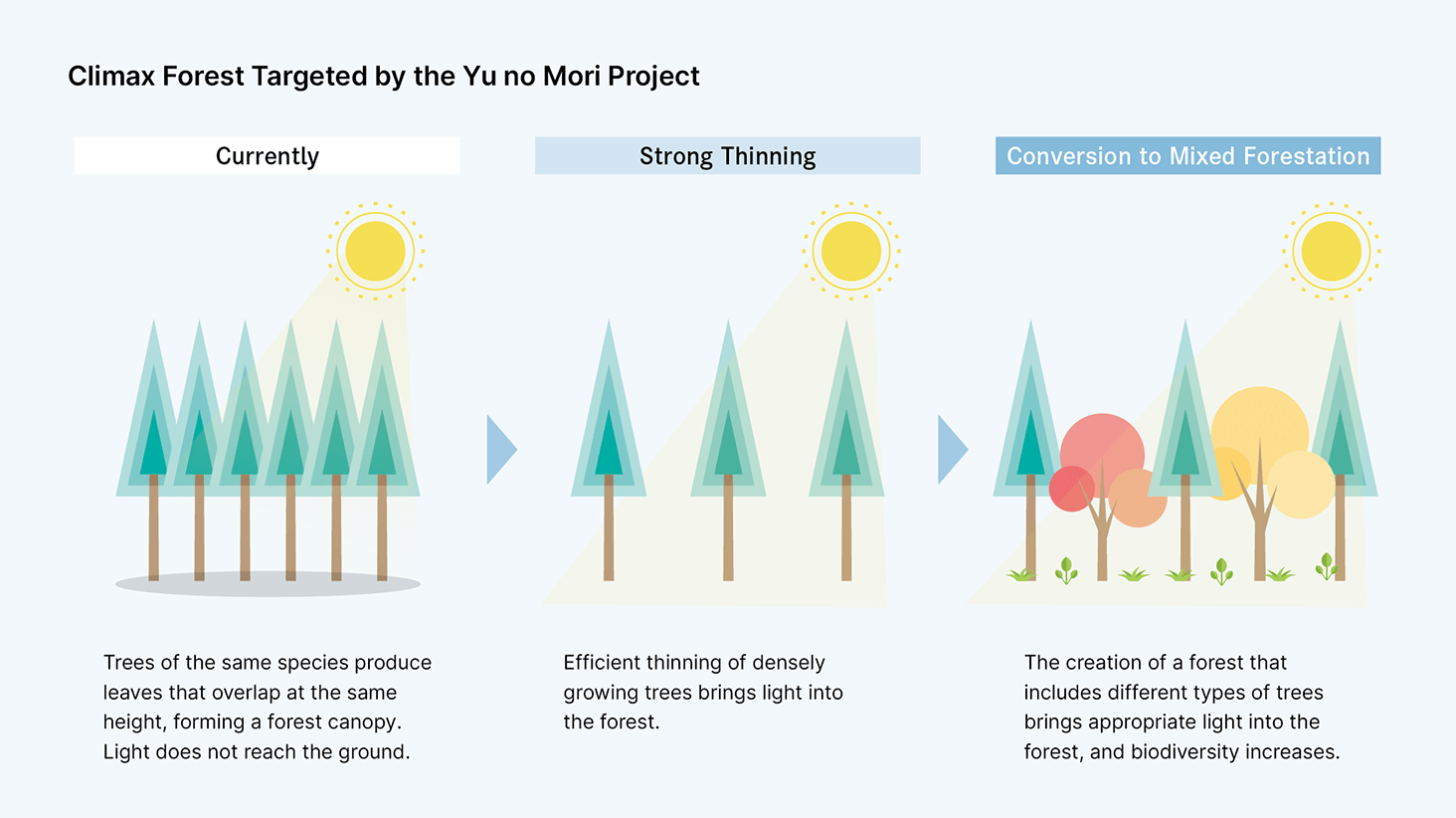
Japan has an ancient tradition of creating woodlands around farming villages. However, Maniwa says this tradition is under threat.
“People modified the forests to suit their lifestyles. They inherited the wisdom of living in harmony with nature and knew how to select and plant trees not only for fuel but also for wind protection and sunlight. With modernization, however, these village woodlands and the legacy of wisdom have been rapidly lost.”
The Yu no Mori project includes plans to develop the area with consideration for village woodlands. Maniwa summarizes the role of village woodlands in the project.
“We plan to split the area into two zones: a village woodland (environmental education) zone and an ecosystem preservation zone. In the former zone, we will replicate traditional village woodlands by planting such trees as persimmon trees and by pumping up groundwater to create a biotope. We want to create woodlands where fireflies can be seen. In the latter zone, our goal is regeneration that has a scientific basis. By introducing and attracting various plants and animals, we aim to create a forest inhabited by owls, which is evidence of a functioning food chain.”
Future Envisioned by the Yu no Mori Project
Other companies are also involved in forest development. However, a feature of the Yu no Mori project is that Group employees themselves are developing the forest. Maniwa emphasizes the project’s distinctive approach.
“Rather than one-time participation in a voluntary activity, we want to make it a more fulfilling experience so that employees want to return again and again.”
He is currently working on many different ideas for the future, including building treehouses and holding mokuiku (“growing with trees”) workshops that provide wood-use education.
We are also exploring partnership initiatives with Gotemba. In April 2022, NYK concluded a partnership agreement with the city on regional revitalization through forest development. Our plans call for the provision of environmental education to local elementary school students. Further, we aim to regenerate the forest through close collaboration between Group employees and local residents.
Okita has high ambitions for the project, which he wants to make a success by mobilizing the entire NYK Group.
“Ongoing reforestation over the long term is paramount. We will consider establishing systems that help all NYK Group employees to continually remain involved in the project.”
In addition, Maniwa underscores the importance of the project having a broad impact.
“Ultimately, we want not only NYK Group employees but also a wide range of stakeholders from both inside and outside the Group to participate in the project. When participants think about why regeneration work is needed and how it will change the forest so they develop an awareness that is applicable to their work and day-to-day lives.”
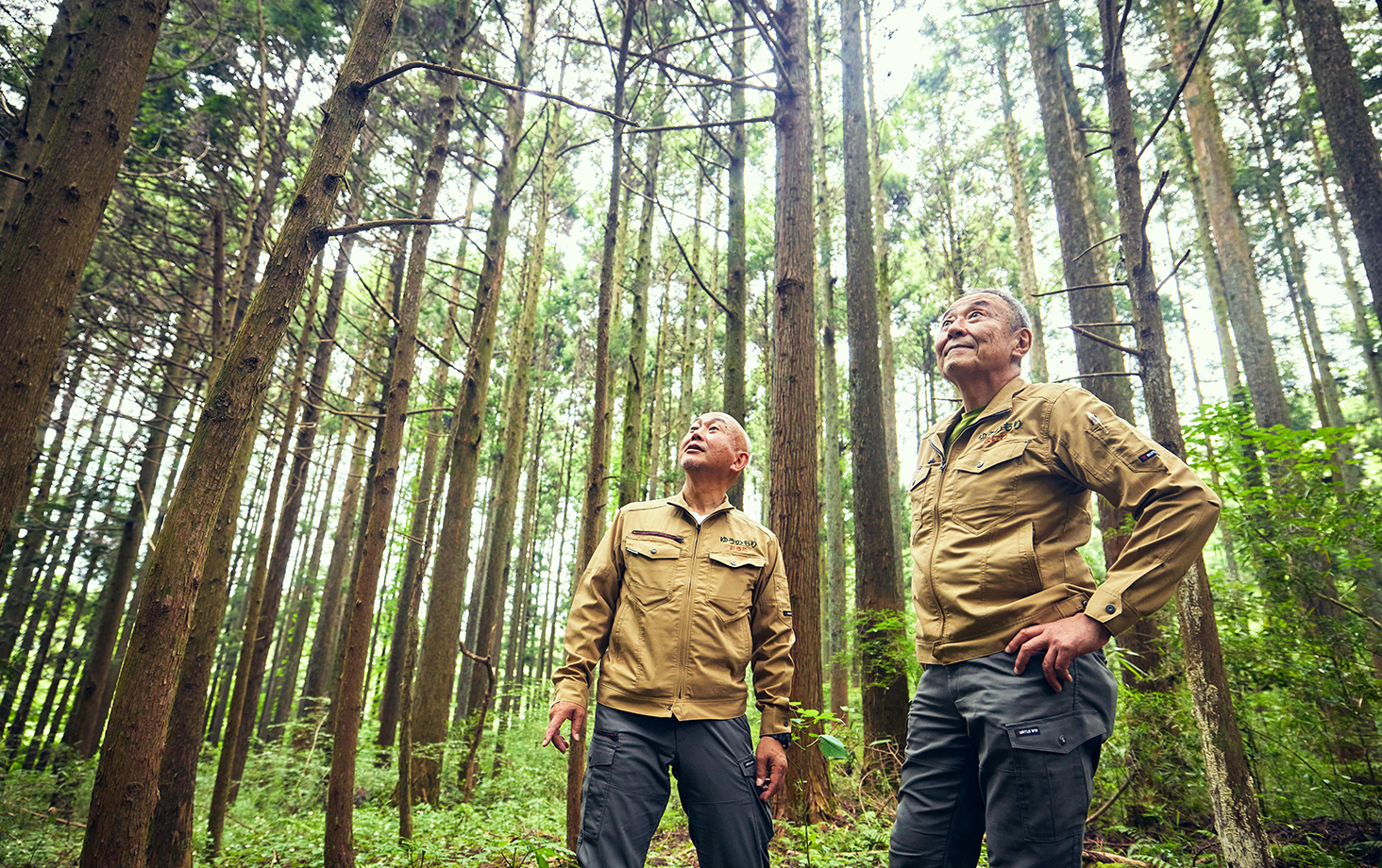
As they work in unison to tackle forest issues, Group employees and local residents are likely to make a variety of discoveries. This process of discovery will provide insight into interactions between people and nature and between people and society, thereby helping open the way to a more sustainable future.
(Interview on June 9, 2023)
- *1 NYK Group Sustainability Initiatives
An NYK Group framework that aims to proactively resolve social and environmental issues under the theme of giving back to the oceans, earth, and people and to enhance corporate value for all stakeholders through these activities - *2 Area related to forests
Forest percentages and man-made forest percentages by prefecture, Forestry Agency website





